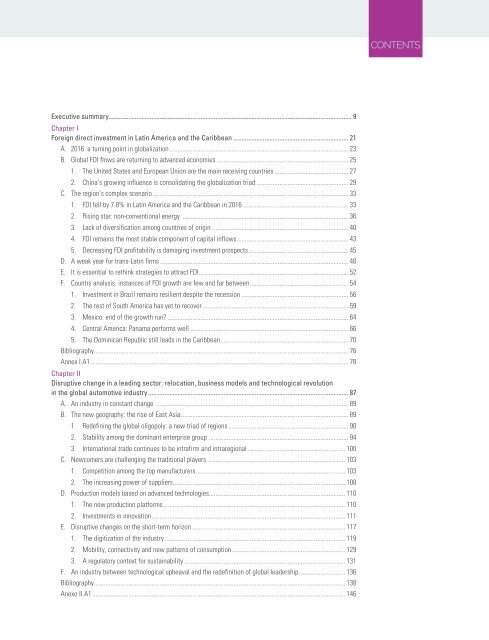Foreign Direct Investment in Latin America and the Caribbean 2017
This publication sets out and analyses the main foreign direct investment (FDI) trends in the countries of Latin America and the Caribbean. The 2017 edition shows that the region is at a difficult juncture. FDI inflows declined by 7.9% in 2016, to US$ 167.043 billion, representing a cumulative fall of 17.0% since the peak in 2011. The fall in commodity prices continues to affect investments in natural resources, sluggish economic growth in several countries has slowed the flow of market-seeking capital, and the global backdrop of technological sophistication and expansion of the digital economy has concentrated transnational investments in developed economies.
This publication sets out and analyses the main foreign direct investment (FDI) trends in the countries of Latin America and the Caribbean. The 2017 edition shows that the region is at a difficult juncture. FDI inflows declined by 7.9% in 2016, to US$ 167.043 billion, representing a cumulative fall of 17.0% since the peak in 2011. The fall in commodity prices continues to affect investments in natural resources, sluggish economic growth in several countries has slowed the flow of market-seeking capital, and the global backdrop of technological sophistication and expansion of the digital economy has concentrated transnational investments in developed economies.
Create successful ePaper yourself
Turn your PDF publications into a flip-book with our unique Google optimized e-Paper software.
<strong>Foreign</strong> <strong>Direct</strong> <strong>Investment</strong> <strong>in</strong> Lat<strong>in</strong> <strong>America</strong> <strong>and</strong> <strong>the</strong> <strong>Caribbean</strong> • <strong>2017</strong><br />
Contents<br />
3<br />
CONTENTS<br />
Executive summary.................................................................................................................................................... 9<br />
Chapter I<br />
<strong>Foreign</strong> direct <strong>in</strong>vestment <strong>in</strong> Lat<strong>in</strong> <strong>America</strong> <strong>and</strong> <strong>the</strong> <strong>Caribbean</strong>....................................................................... 21<br />
A. 2016: a turn<strong>in</strong>g po<strong>in</strong>t <strong>in</strong> globalization.............................................................................................................. 23<br />
B. Global FDI flows are return<strong>in</strong>g to advanced economies................................................................................. 25<br />
1. The United States <strong>and</strong> European Union are <strong>the</strong> ma<strong>in</strong> receiv<strong>in</strong>g countries.............................................. 27<br />
2. Ch<strong>in</strong>a’s grow<strong>in</strong>g <strong>in</strong>fluence is consolidat<strong>in</strong>g <strong>the</strong> globalization triad......................................................... 29<br />
C. The region’s complex scenario........................................................................................................................ 33<br />
1. FDI fell by 7.8% <strong>in</strong> Lat<strong>in</strong> <strong>America</strong> <strong>and</strong> <strong>the</strong> <strong>Caribbean</strong> <strong>in</strong> 2016................................................................. 33<br />
2. Ris<strong>in</strong>g star: non-conventional energy ...................................................................................................... 36<br />
3. Lack of diversification among countries of orig<strong>in</strong>.................................................................................... 40<br />
4. FDI rema<strong>in</strong>s <strong>the</strong> most stable component of capital <strong>in</strong>flows..................................................................... 43<br />
5. Decreas<strong>in</strong>g FDI profitability is damag<strong>in</strong>g <strong>in</strong>vestment prospects.............................................................. 45<br />
D. A weak year for trans-Lat<strong>in</strong> firms.................................................................................................................... 48<br />
E. It is essential to reth<strong>in</strong>k strategies to attract FDI............................................................................................ 52<br />
F. Country analysis: <strong>in</strong>stances of FDI growth are few <strong>and</strong> far between............................................................. 54<br />
1. <strong>Investment</strong> <strong>in</strong> Brazil rema<strong>in</strong>s resilient despite <strong>the</strong> recession.................................................................. 56<br />
2. The rest of South <strong>America</strong> has yet to recover.......................................................................................... 59<br />
3. Mexico: end of <strong>the</strong> growth run? .............................................................................................................. 64<br />
4. Central <strong>America</strong>: Panama performs well ................................................................................................. 66<br />
5. The Dom<strong>in</strong>ican Republic still leads <strong>in</strong> <strong>the</strong> <strong>Caribbean</strong>............................................................................... 70<br />
Bibliography............................................................................................................................................................ 76<br />
Annex I.A1.............................................................................................................................................................. 78<br />
Chapter II<br />
Disruptive change <strong>in</strong> a lead<strong>in</strong>g sector: relocation, bus<strong>in</strong>ess models <strong>and</strong> technological revolution<br />
<strong>in</strong> <strong>the</strong> global automotive <strong>in</strong>dustry........................................................................................................................... 87<br />
A. An <strong>in</strong>dustry <strong>in</strong> constant change ...................................................................................................................... 89<br />
B. The new geography: <strong>the</strong> rise of East Asia....................................................................................................... 89<br />
1. Redef<strong>in</strong><strong>in</strong>g <strong>the</strong> global oligopoly: a new triad of regions.......................................................................... 90<br />
2. Stability among <strong>the</strong> dom<strong>in</strong>ant enterprise group ...................................................................................... 94<br />
3. International trade cont<strong>in</strong>ues to be <strong>in</strong>trafirm <strong>and</strong> <strong>in</strong>traregional............................................................ 100<br />
C. Newcomers are challeng<strong>in</strong>g <strong>the</strong> traditional players..................................................................................... 103<br />
1. Competition among <strong>the</strong> top manufacturers............................................................................................ 103<br />
2. The <strong>in</strong>creas<strong>in</strong>g power of suppliers......................................................................................................... 108<br />
D. Production models based on advanced technologies................................................................................... 110<br />
1. The new production platforms................................................................................................................ 110<br />
2. <strong>Investment</strong>s <strong>in</strong> <strong>in</strong>novation....................................................................................................................... 111<br />
E. Disruptive changes on <strong>the</strong> short-term horizon.............................................................................................. 117<br />
1. The digitization of <strong>the</strong> <strong>in</strong>dustry............................................................................................................... 119<br />
2. Mobility, connectivity <strong>and</strong> new patterns of consumption...................................................................... 129<br />
3. A regulatory context for susta<strong>in</strong>ability................................................................................................... 131<br />
F. An <strong>in</strong>dustry between technological upheaval <strong>and</strong> <strong>the</strong> redef<strong>in</strong>ition of global leadership............................. 136<br />
Bibliography.......................................................................................................................................................... 138<br />
Anexo II.A1........................................................................................................................................................... 146


















